Peter Millett
Metal Sculpture
Floor and Pedestal Sculpture - Metal
Wall Mounted Sculpture - Metal
Corten - suitable for exterior
Wood Sculpture
Floor and Pedestal Sculpture - Wood
Wall Mounted Sculpture - Wood
Work on Paper
Painting
About
Exhibitions
Recent Outdoor Sculpture, May 17 - June 30, 2012
Sculpture, July 1 – August 14, 2010
Oysterville: Drawings from the Espy Foundation Residency, January 5 - February 11, 2006
Color of Time - New Sculpture, September 2 - October 9, 2004
Studies | Small Wood and Metal Sculpture, January 4 - 27, 2001
Touch – Sculpture in Metal and Wood and Works on Paper, November 4 - December 15, 1999
Sculpture, November 4 - 28, 1993
Wood Knots, April 2 - May 3, 1992
-
Peter Millett was born in 1949 in Evanston, IL and resides in Seattle. He received his BFA at the Rhode Island School of Design and his MFA at University of Washington. His work is in the permanent collections of Museum of Modern Art, New York; San Francisco Museum of Modern Art; Microsoft Corporation, Redmond; Tacoma Art Museum; Seattle Art Museum and Henry Art Gallery, Seattle. The artist lives and works in Seattle.
-
Born in 1949 in Evanston, IL; resides in Seattle.
EDUCATION
1973-75 University of Washington, Seattle
1971 B.F.A., Rhode Island School of Design
SELECTED ONE-PERSON EXHIBITIONS
2020
Greg Kucera Gallery, Seattle (also 2001, 2000, 1999, 1997, 1993, 1992, 2006, 2010, 2015)
2002
Robischon Gallery, Denver, CO
1999
Allene Lapides Gallery, Santa Fe, NM
1996
Ochi Gallery, Ketchum, ID (also 1994)
1991
Gateway Tower Gallery, Seattle
1990
Donnally Books, Seattle (also 1984, 1986)
SAFECO Corporation Plaza, Seattle
1989
Shoshana Wayne Gallery, Santa Monica, CA
1988
Documents Northwest: The PONCHO Series, Seattle Art Museum
1983
Linda Farris Gallery, Seattle (also 1981)
1982
Grapestake Gallery, San Francisco, CA
1978
Foster/White Gallery, Seattle
1976
Polly Friedlander Gallery, Seattle
SELECTED GROUP EXHIBITIONS
2012
Presence / Absence, Bellevue College, Bellevue, WA
1999
Structure, Air Touch Cellular, Bellevue, WA
1998
Betty Bowen Award 20th Anniversary Exhibition, Washington State Convention and Trade Center, Seattle WA
1997
Pure Form: The Intensity of Process, Portland Institute for Contemporary Art, Portland, OR
West Coast Painting and Sculpture 1997 (continuous slide presentation), Oceanside Museum of Art, Oceanside, CA
1996
Marking Time, Kittredge Gallery, University of Puget Sound, Tacoma, WA
On Paper, In Wood, Museum of Northwest Art, La Conner, WA
1995
The Traditional Impulse, Greg Kucera Gallery
Pinocchio: Sculpture Made of Carved and Painted Wood, Cheney Cowles Museum, Spokane, WA
1994
Introductions, Soma Gallery, San Diego, CA
Drawings, Kirkland Arts Center, Kirkland, WA
Fallen Timber, Tacoma Art Museum
1993
Between Black and White, Greg Kucera Gallery, Seattle
1992-93
The Betty Bowen Legacy: Fourteen Years of Award Winning Art, Security Pacific Gallery, Seattle
1992
Greg Kucera Gallery, Seattle
Spirit of the West, traveling exhibition, sponsored by West One Bank
1990
Watercolor 3, Bellevue Art Museum
1989
100 Years of Washington Art: New Perspectives, Tacoma Art Museum
1988
Contemporary Paintings, Prints and Drawings '88, Ishikawa Prefectural Museum of Art, Ishikawa, Japan
Visible Difference, Cheney Cowles Museum, Spokane, WA
1987
Focus Seattle, San Jose Museum of Art
Invitational Drawing Exhibition, Seattle Pacific University
Bumberbiennale: Seattle Sculpture 1927-1987, Seattle Center
West Coast Painters Invitational, University Gallery, University of Hawaii, Hilo
1986
Northwest Impressions, Henry Gallery, University of Washington, Seattle
Drawing Power, Lynn McAllister Gallery, Seattle
1985
Painted Structures, Henry Gallery, University of Washington, Seattle
1981
Portopia '81, Washington State Pavilion, Kobe, Japan
Assemblages: The Private Icon, Henry Gallery, University of Washington, Seattle
1980
New Ideas #3, Seattle Art Museum
Selections from the Museum's Modern Art Collection, Seattle Art Museum
Cornish Faculty, Institute for Pedagogical Studies, Vladivostok, Siberia, USSR
1976
Works on Paper, Seattle Art Museum
PUBLIC COMMISSIONS, GRANTS, AWARDS
2000 Artist Trust Grant
1999 Seattle Artists, Seattle Arts Commission
1991 Exterior plaza sculpture, AT&T Gateway Tower, Seattle
1987 Betty Bowen Committee Special Recognition Award, Seattle Art Museum, WA
1986 Washington State Arts Commission, sculpture for Art in Public Places, Mountain View, WA
COLLECTIONS
Boeing Corporation, Chicago
City of Seattle
Continental Bank, Chicago
Henry Art Gallery, University of Washington, Seattle
Museum of Modern Art, New York
Microsoft Corporation, Redmond
PACCAR Corporation, Seattle
SAFECO Insurance Corporation, Seattle
San Francisco Museum of Modern Art
Seattle Art Museum
Security Pacific Bank, Seattle
Seattle First National Bank, Seattle
Simpson Investment Company, Seattle
Swedish Hospital Medical Center, Seattle
Tacoma Art Museum, WA
U.S. West Communications, Seattle
-
Sept - Oct 2024 issue
Preview Art Magazine
Peter Millett: Silver
by Matthew Kangas
September 4, 2024
The Seattle Times
Top Seattle shows to see in fall 2024
by Margo VansynghelMay 2 - 30, 2012
Bellevue College
Presence / Absence
Watch the de-installation on youtubeJuly 22, 2010
The Seattle Times
Changing perceptions: Peter Millett's sculptures need to be circled to be seen
by Michael Upchurch
(open pdf here)January 19, 2001
Seattle Post-Intelligencer
No problem with Ruminations' lack of personality
by Victoria JosslinSeattle sculptor Peter Millett's work fits into a major topic of the past few millenniums, the question of how to reconcile body and spirit. While I wouldn't go so far as to say that he has solved the problem, his work does raise the subject and he finds a balance point.
Millett uses wood here and emphasizes its grain and its surface by washing it with a chalky casein paint, and in some cases waxing and polishing it.
The simple shapes work themselves out in two directions simultaneously. The first is through permutations of form. Millett takes a few modular forms through many changes, playing with repetition, inversion, symmetry and transposition. It's the clever, playfully conceptual aspect of the work, and can be very beautiful, as in "Blue Balls."
The second direction is the insistent physicality, the woodness, of the work. It is odd enough that while the artist plays up the material, it's still hard to read it as wood. The rounded, creased and folded shapes look like origami, or sheet metal sculpture, not wood.
Beyond that, though, the simple pieces unavoidably recall the round symmetry of the human body. These small pieces repay careful looking. You find hints and suggestions of the interaction of the artist's hand and the flesh like material. And you find happy moments of colored pencils or crayons sunk into the wood and claiming to act as pegs, holding the little construction together.
November 18, 1999
Seattle Times
“Millett's Sculptures Give the Illusion of Motion”
by Sheila FarrBeing in a room of Peter Millett's sculpture is like watching a Balanchine ballet. There's the same economy and precision of form, the honed craftsmanship - and then the surprise of a leg flung skyward, foot flexed. Millett makes clean spare lines seem as sexy and provocative as Balanchine's leggy ballerinas, stretched and prodded into grace.
Millett's work is stationary, of course, but the images take on a kind of time-lapse motion with each step you take. Walk around the pedestal that holds "Double Steel" or "Pipe Post" and you witness transformation. You'll see a rectangle enclosing creased curves, like those of a human torso pressed against limbs, that shifts to the coupling of ovals and straight lines in cavernous spaces. Another step and a concoction of shadows and emptiness confronts you as you peer through the piece and light plays on its crevices.
The two sculptures are composed of sliced and welded steel pipes, their exterior surfaces rubbed to a mottled glow. Millett has been working with these same forms for years but using chunks of log instead of steel. The hollow cylinders give interior dimensions to the work, creating an intricate simplicity that satisfies the eye.
It's hard to write about modern sculpture without falling into clichés. I've never been able to define what makes Tony Smith's sculpture so powerful, and Millett owes a lot to Smith. It has something to do with the kaleidoscopic effect of the work's changing relationship of shapes as you move around it, a primitive pleasure like watching the mutable surface of water or fire. That, combined with the satisfaction of the work's orderliness, is what brings Balanchine to mind - all fluid geometry and supple tension.
But there has to be something unexpected as well, something a little wild or perverse, which Balanchine is famous for. In Japanese aesthetics, it's the idea of never having something be immaculate, but always throwing in a reminder of our mortality and fallibility. It might be a dry branch in a flower arrangement, a little awkward stutter of movement in a classical ballet adagio, or a jazzy improvisation in an otherwise predictable sculptural assemblage.
Millett's wall piece, "Receiver," is like that. It's an octagon of cut poles, spiked with electric blue shadows and a flourish of extra parts. One section of the form, instead of being a single piece of wood, is an elegant patchwork that undermines the visual symmetry of the piece while leaving it symmetrical in form. It's thrilling. Humans may love repetition and predictability, but we hate being bored. "Receiver" gives the pleasure of the unexpected along with the soothing sense of knowing what is coming next.
For me, the most interesting part of this discussion is that anybody can learn that concept, but not everybody can make it work. If you give a pile of grapes to a hundred different people, one of them may turn it into a great bottle of wine, and it doesn't always depend on how much they know about the process. Sometimes a happy accident determines the result. Modern sculpture may look easy, as if anybody with a few basic skills can do it, but that's far from true. Think of how much unengaging work there is out there.
Millett's forms are vital. They express something essential about our way of being and also suggest the rhythms of the external world. Take the wooden wall piece "Jolt," one of the simplest shapes in this show, absolutely compelling in its relationships and proportions. All energy, it streaks down the wall like lightning from heaven and then flings itself back up in a startled, Balanchine arabesque.
November 19, 1999
Seattle Post-Intelligencer
Millett Cuts Back to Essence of Beauty
by Regina HackettPeter Millett's "Black Box" is blue, a smoky blue painted on sections of cedar sanded to a voluptuous unity and hanging on the wall at the Greg Kucera Gallery.
As a title, "Black Box" is distinctly odd, as it refers to those tough repositories of flight information examined for clues after a crash. All the interest, obviously, is on the inside, yet Millett's sculpture is sealed shut, its parts irrevocably fused.
In essence, the title refers to Millett's version of Platonic intent. The rigorous pleasures of his abstractions are meant to suggest Platonic ideals, those divine forms hidden by the shadowy world of the senses.
But isn't art necessarily committed to an engagement with the surface of things? Some artists say no, such as Sol LeWitt, who once buried a drawing in a box in a location only he knows. Afterward, he sold it to a collector who got a certificate of ownership and LeWitt's unsubstantiated word that the drawing actually exists.
The value in this case lies not in the drawing but in the concept of the drawing, which takes Conceptualism to its outer limits.
Although Seattle's Millett is on a similar track, he isn't nearly as reductive. In both his sculptures and drawings, he pares down to fundamental shapes only to make sensuous use of them, finding in his reductions an economical essence of the beautiful.
In "Receiver," sanded down cedar poles join to make a diamond, 22 inches high by 22 inches wide and 6-1/2 inches deep. Its symmetry is animated by mismatched parts, and the simplicity of its appearance hides the complexity of its intent. Along the edges are splatters of Yves Klein blue, a startling, star-struck blue, intense but powdery. They are not remnants of exterior color but bursts of inner life.
Sculptor Robert Morris once observed that there's a continuum in sculpture from the monument to the ornament. Millett's ambition is nothing less than to collapse this continuum, producing monuments that are intimate because their deep structures are imbued with a sense of the ornamental.
"Wooden Curve" is a half-circle projecting into space from the wall, 39 inches high by 19-1/2 inches wide and 5-1/2 inches deep, a meditation on the notion of inner and outer space.
Most of Millett's metal sculptures engage in a fluid interplay between inner and outer spaces. The jewel-like "Luna Media II," 12-1/2 inches high by 8 1/2 inches wide and 8-1/2 inches deep, is welded steel imitating a tarnished emerald seashell.
"Pipe Post" (welded steel, 37 inches high by 12-1/2 inches wide by 9 inches deep) is a material form assuming the guise of an inflected mantra, bent knees turning into bullhorns.
Millett began as a painter and proves in this exhibit he has lost none of his considerable gifts as a colorist. Using gouache on paper, he achieves something close to what Joseph Goldberg and early Brice Marden achieved with encaustic: simple shapes imbued with complex tonal radiances.
"Blue Diamond" (gouache on paper, 39 inches high by 26 inches wide) presents a treasure-trove of variegated yellows parting, like curtains, to reveal a diamond wedge of deep blue.
-
Sanctuary, 2020 - exhibition overview
Works for Sanctuary, 2020 - in Peter’s studio
Peter Millett discussing his works: OPEN TRIANGLE, DOUBLE LONG GREEN, BOX, 2020
Peter Millett discussing his work: PENTAGON, 2019
Peter Millett discussing his works: GREEN HOUSE, and HIDEOUT, 2019
Peter Millett discussing his work: LEAP, 2019
Peter Millett discussing his work: WHITE SQUALL, 2020



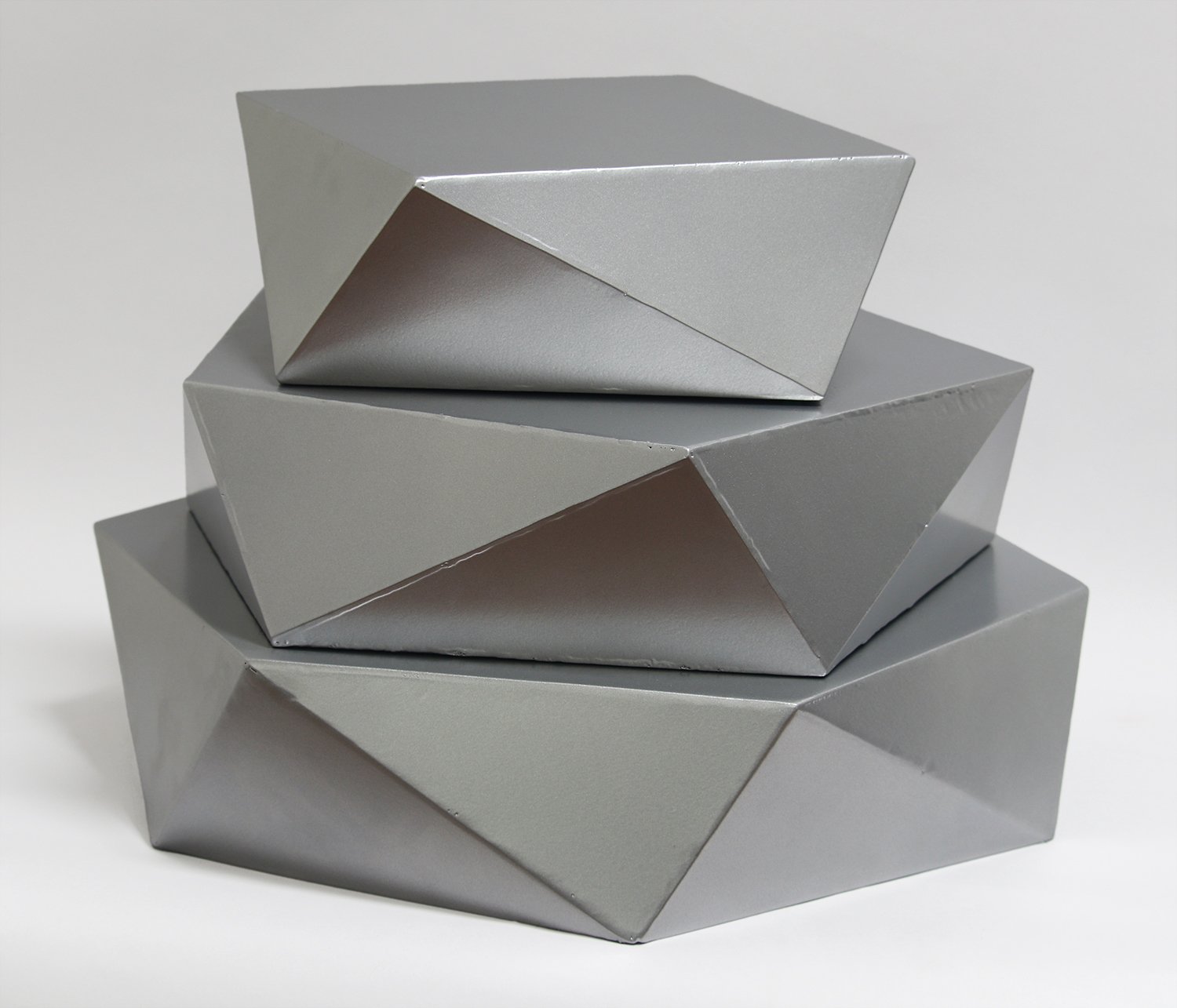



































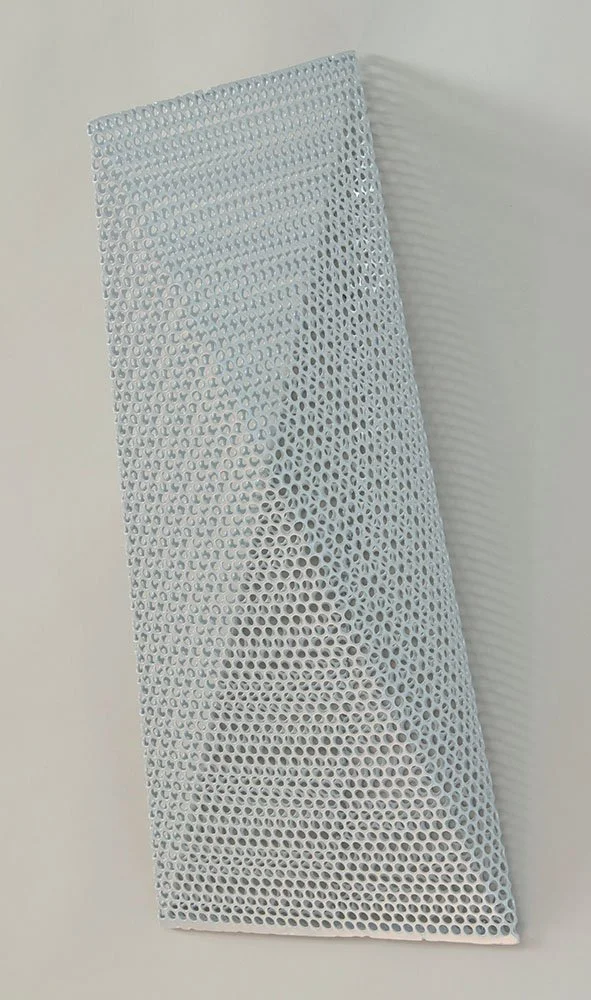

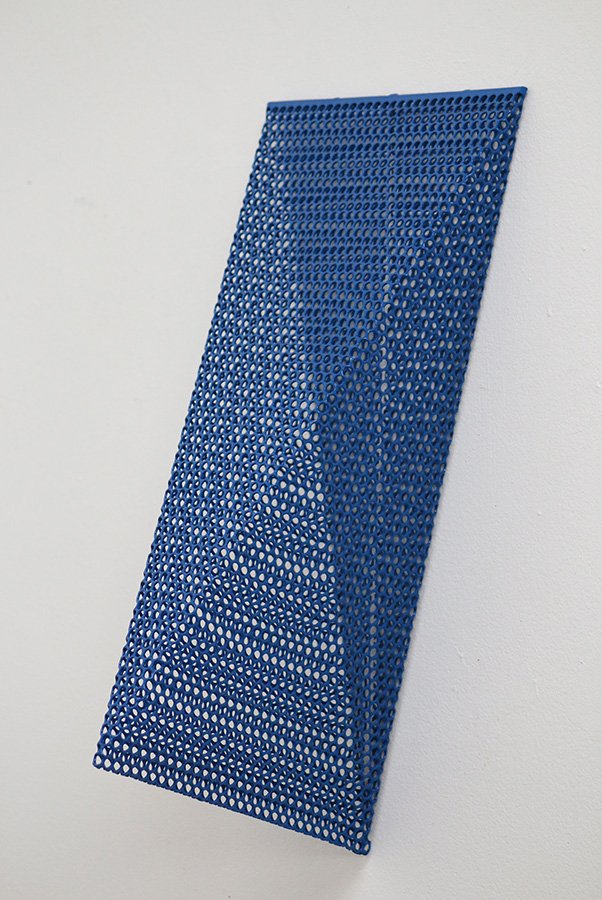
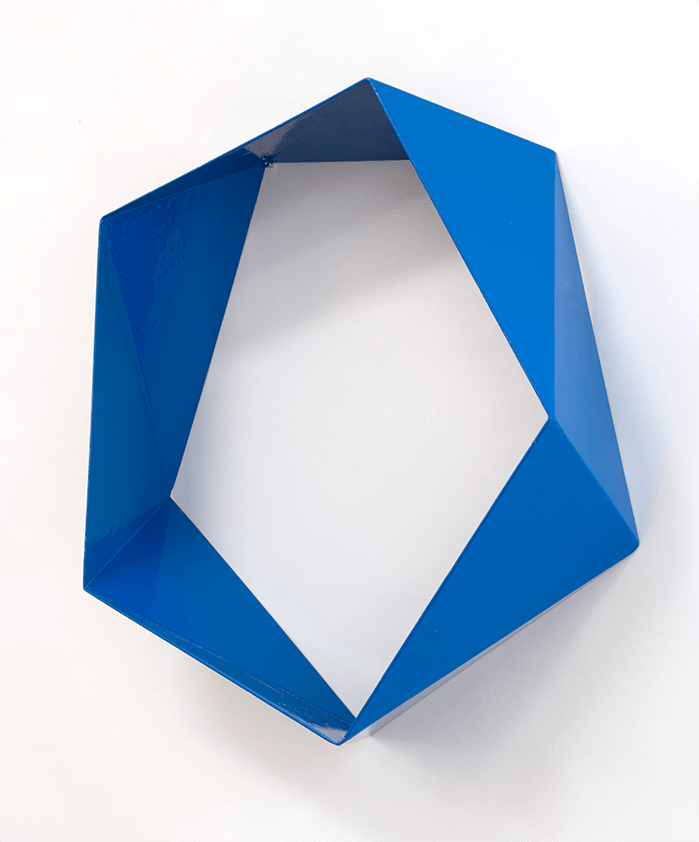




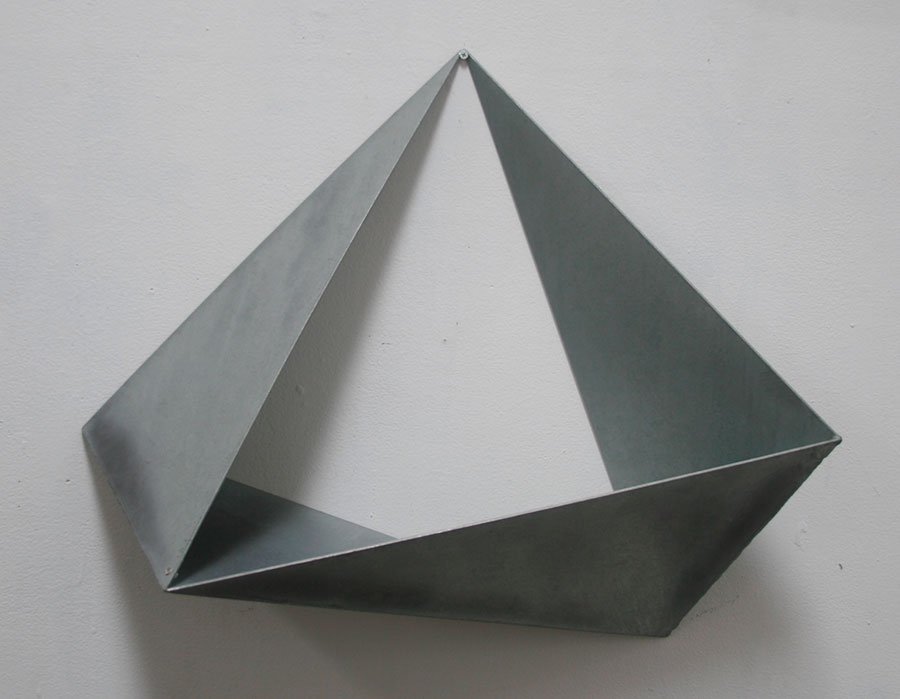




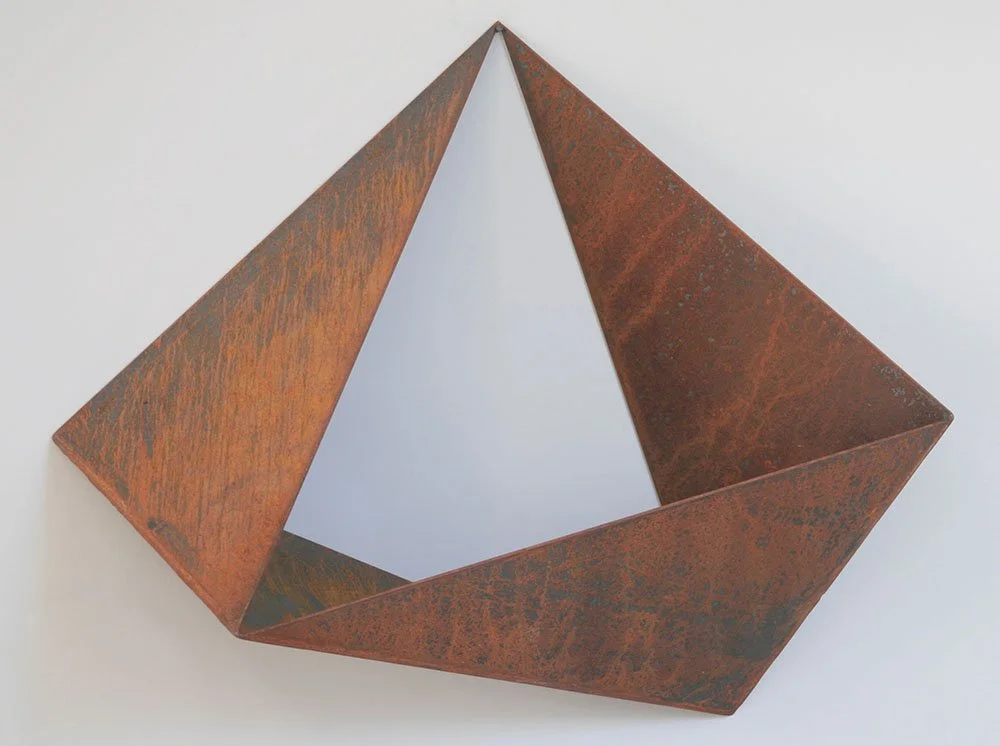













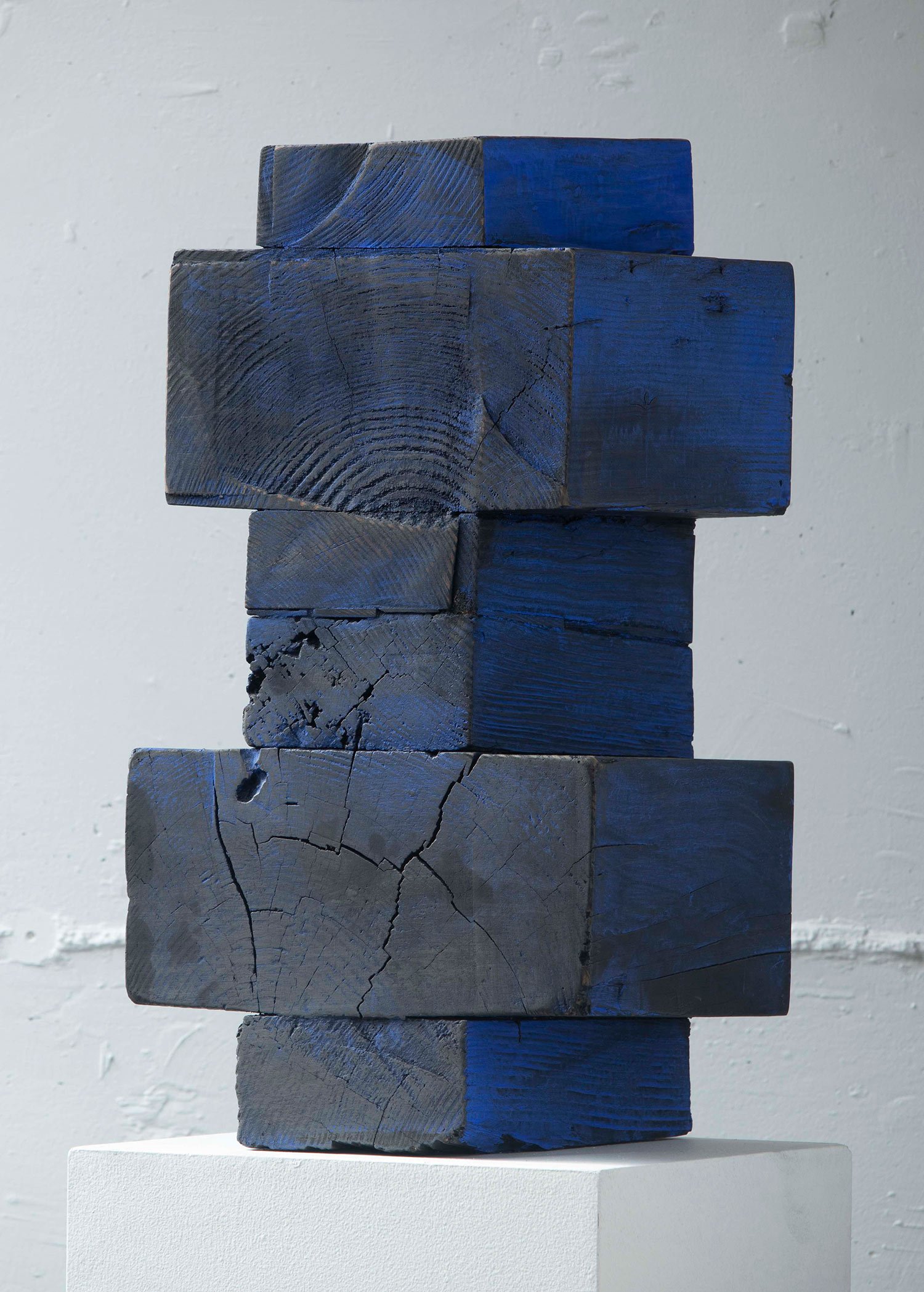























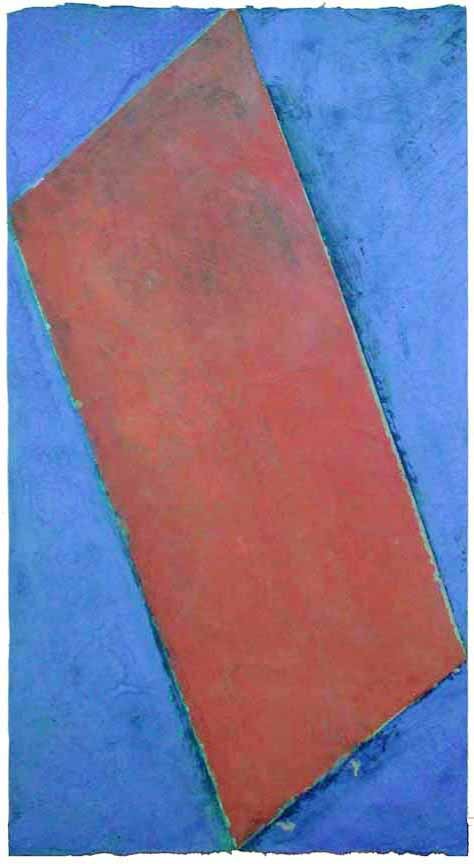








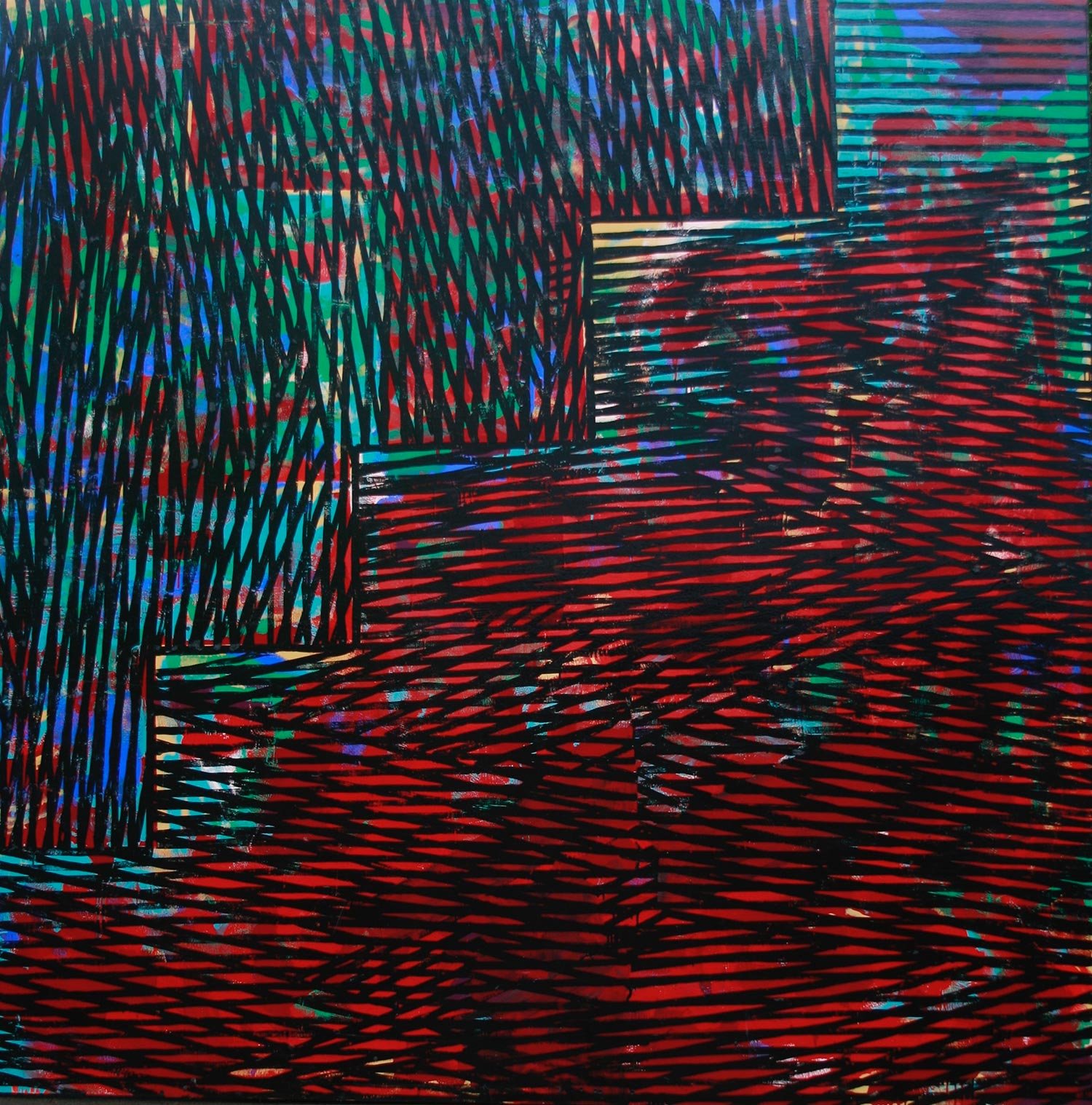


Powder coated steel
98 x 21 x 21 inches each
$30,000